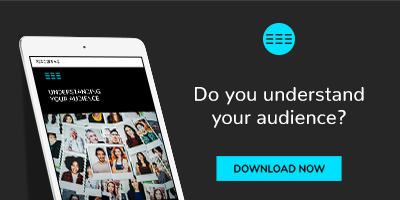
Related content: Understanding Your Audience [a free guide]
Market segmentation
Market segmentation identifies different groups of potential customers in your market. These groups are usually based on a mix of characteristics such as demographic, behavioural, psychographic and needs. Some may not have much interest in your offerings while others may be very interested. Market segmentation is the first important step in understanding your market and should be done before determining your target audience.
You should do market segmentation when:
- You want to assess the size of the market for a new product.
- You’re looking to find white space opportunities you can move into.
- You want to identify your ideal consumer for your product or service.
Read more: Everything you need to know about the 6 types of market segmentation
Target audience
Where market segmentation looks at the market as a whole and groups consumers according to a multitude of factors (e.g. income, lifestyle, location, gender, age, personality traits, purchase patterns), target audience identifies and understands the group of consumers most likely to buy your product or service. A target audience is usually identified during market segmentation.
Also referred to as target market, this is the second step in understanding which consumers are in the best position to buy your product or service. For example, many New Zealanders might like the idea of having a spa at their home, however, a smaller number of those potential prospects will have the finances, space, and requisite home ownership to purchase one.
You should define your target audience:
- During the early stages of any new product development to ensure there is enough demand for your product/service to make it viable.
- When creating customer segments and buyer personas.
- If you’re looking to undertake in-depth market qualitative or quantitative research. This stage is especially important if you want to understand the purchase drivers, price points and buying behaviours of specific consumers who a relevant to your brand.
Customer segmentation
While market segmentation offers a broad view of the market and identifies your target audience, customer segmentation is about uncovering customer types within your current customer base. Much like market segmentation, customer segmentation groups customers by demographics, behaviours, lifestyle, needs, and psychographic traits. However, unlike market segmentation, customer segmentation also includes additional layers of customer information you have on your customers. This can include their previous interactions with your brand, purchase history, customer lifetime value, frequency of visits/purchase, time and/or dates of their visits, amount last spent and so on.
Customer segmentation is an excellent way to better understand the traits your most profitable customer groups share, what their needs are (which can vary from segment to segment), how well you are meeting those needs and how you can meet them better going forward. Customer segmentation is also particularly useful for uncovering profitable customer segments you may be currently underserving or developing strategies to improve your brand's performance among certain customer groups.
You should do customer segmentation to:
- Identify who your most profitable customers are.
- Refine and target your marketing and promotional activities towards specific customer types.
- Uncover new untapped opportunities in your customer base.
- Start building buyer personas.
Read more: 5 questions to ask before targeting customer segments
Buyer personas
Buyer personas (also called marketing personas) are fictionalised characters based on your customer segments and help marketers understand the lived experience of those customers. They provide context around a segment’s needs and behaviours, the challenges they’re facing, what motivates them to purchase, and what aspects of a product or service they consider most important. For example, one persona might say price is the most important factor when buying while another may say quality or usability. Personas are a critical tool for helping marketers better understand, empathise and ultimately relate to each segment, allowing them to better tailor their marketing and promotions to engage with a segment.
Creating buyer personas will help you:
- Keep your customers’ needs top of mind during product development.
- Optimise your advertising and marketing.
- Create tailored and engaging content around your offerings, such as video, blogs, or emails.
- Better target your social media ads.
- Sort and prioritise leads based on persona.
- Maintain a customer-focused approach in your business.
Read more: 3 common mistakes to avoid when creating buyer personas
As you can see, there are different stages in your business development as well as different departments that can benefit from segmentation. While there are some overlaps in the different types of segmentation, all serve a specific purpose and can unveil important features about your market and customers that will help you better meet their needs and engage with them on a personal level.
Learn more about the power of segmentation and how it can enhance your marketing and cut-through with our all-in-one guide: Understanding Your Audience.
